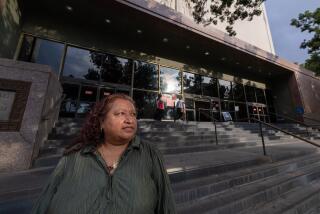‘Divorce Court’ Takes New Stand Against Daytime Competition
In the evolution of television, as in the evolution of intelligent life, organisms must adapt to new surroundings or face the consequences. Such is the case with “Divorce Court,” the syndicated series that began back in TV’s Cro-Magnon age.
Competition from a barrage of daytime talk shows that specialize in the seamier side of life was making it increasingly difficult to attract viewers. “ ‘Oprah,’ ‘Geraldo,’ ‘Donahue’--these are the direct competition,” explains Ron Ziskin, executive producer.
So when the show’s new season begins today, it will be a far different “Divorce Court” than viewers have ever known. The program will attempt to be more realistic, without actually being real. (The show will air locally at 4 p.m. on Channel 13.)
From its inception in 1957 to the end of its first run in 1969, “Divorce Court” consisted mostly of embittered couples hurling vicious accusations at each other from the witness stand. Narration was provided by a whispering announcer, seemingly pulled away from a golf tournament: “While the court takes a brief recess, we’ll pause for a commercial announcement.” The judge was played by an actor and the show had a mission, pronounced daily, “to help stem the rising tide of divorces.”
The series was resurrected in 1984 by Blair Entertainment, which pretty much followed the old format, aside from a few changes. Retired Judge William B. Keene was hired to preside over the cases and real lawyers were used to portray lawyers.
Last year, apparently feeling the need to get in on the “reality” craze that was sweeping TV, the show issued a new statement of purpose--it was a press release, actually--that clarified the series’ intentions. “In the case of ‘Divorce Court,’ ” it said, “the show is less interested in presenting some high-flying concept of realism than it is in presenting reality --in an entertainment form.” (The italics were theirs.)
Whatever that meant, it resulted in cases such as Escobar vs. Escobar, in which a “Cuban-American ex-CIA agent is accused of gun- and drug-running by wife, whom he alleges is sleeping with a renegade CIA agent who wrote a book damning the agency”; and Satin vs. Satin, in which “a construction worker accuses his wife of using her job as a phone sex operator to solicit business as a prostitute. Wife claims alcoholic husband forced her into sexual perversities by threatening violence.”
That didn’t help the ratings, so new producers were brought in to revamp the show this year. The program has been radically restructured and will now be as much a soap opera as a court show.
The real lawyers who played lawyers have been replaced by actors, whose characters will develop over time. Relationships among the attorneys will be revealed. The judge, who is still the same, retired judge, will have more scenes and dialogue away from the bench. New sets have been added to take the action out of the courtroom. Scenes will now take place in the hallway, a cafe, an attorney room, the restrooms and other nearby locales.
And there is no more whispering announcer. Instead, a TV reporter, played by Martha Smith, formerly of “Scarecrow & Mrs. King,” will summarize testimony and interview the litigants, lawyers and judge about the cases.
The show also will use flashbacks to tell the stories. “It makes the show more realistic,” Ziskin says. “Now you can see the motivation.” The show used to rely on dramatic outbursts in the courtroom to explain something that had happened in the past.
Episodes will often focus on social issues, such as battered children, alcoholism, drug dependency and homelessness, the producer said. Toll-free numbers for help with the problems featured in that day’s episode will be given when possible. “I think we can provide useful information to people,” Ziskin says.
But all is not lost for viewers who disdain social relevance. Some of the segments will be just plain kinky. Rock singer Fee Waybill, late of The Tubes, will play a rock star in an episode about a wife whose marriage is torn asunder when she writes a tell-all book about her life as a groupie.
Blair Entertainment has ordered 110 episodes of the remodeled show. Ziskin and co-executive producer Bob Jaffe will churn them all out in eight weeks in a studio in Valencia.
“It’s a mammoth undertaking,” Ziskin says.
Three to four shows are shot every day. While one group is shooting, another is in makeup, another in the rehearsal hall. It’s a marital Angst factory.
More to Read
The complete guide to home viewing
Get Screen Gab for everything about the TV shows and streaming movies everyone’s talking about.
You may occasionally receive promotional content from the Los Angeles Times.






